ServiceNow Bundle
How Did ServiceNow Revolutionize Enterprise Software?
From a single laptop to a $150 billion market cap, the ServiceNow SWOT Analysis reveals a fascinating story of innovation and disruption. Founded in 2004 by Fred Luddy, the company's journey from a cloud-based IT solution to a leading AI platform is nothing short of remarkable. Let's explore the brief history of ServiceNow and how it transformed digital workflows.
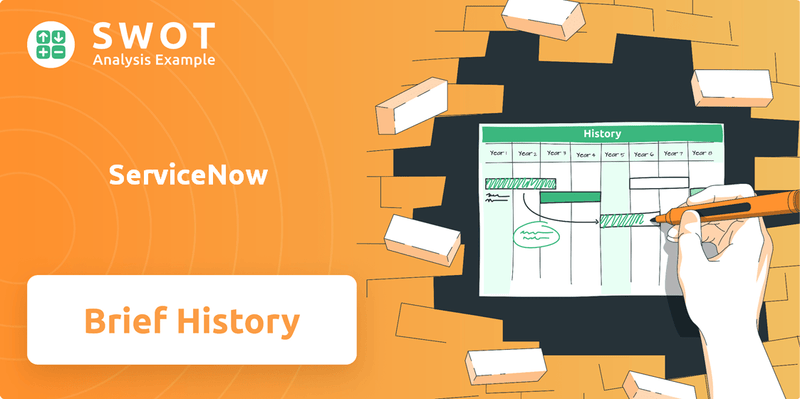
This exploration into the ServiceNow company background will uncover its origins story, tracing its evolution from its early days as Glidesoft, Inc. to its current position. We'll examine key milestones, including the ServiceNow founder's vision and the strategic acquisitions that fueled its growth trajectory. Understanding the ServiceNow platform's impact on IT service management provides valuable insights.
What is the ServiceNow Founding Story?
The story of the ServiceNow company began in 2004 as Glidesoft, Inc., founded by Fred Luddy. Luddy, looking to rebuild after a challenging experience at Peregrine Systems, set out to create a cloud-based solution for managing IT workflows. This marked the beginning of what would become a leading platform in the enterprise software space.
Luddy's vision was to revolutionize how businesses managed their IT operations, moving away from complex, on-premise systems. The company's early days were marked by bootstrapping and a focus on developing a simple, cloud-based help desk solution. This initial focus set the stage for ServiceNow's future growth and its impact on IT service management.
The company's early days were marked by bootstrapping and a focus on developing a simple, cloud-based help desk solution. In mid-2005, the company secured its first venture financing, a $2.5 million investment from JMI Equity, which allowed it to expand its team.
Fred Luddy founded ServiceNow in 2004 as Glidesoft, Inc., with a vision to transform IT service management.
- 2004: Fred Luddy incorporates Glidesoft, Inc. in California.
- 2005: Secured $2.5 million in venture financing from JMI Equity.
- 2006: The company officially changed its name to Service-Now.com.
- Luddy's experience and vision were key to the company's early success in cloud computing.
ServiceNow SWOT Analysis
- Complete SWOT Breakdown
- Fully Customizable
- Editable in Excel & Word
- Professional Formatting
- Investor-Ready Format
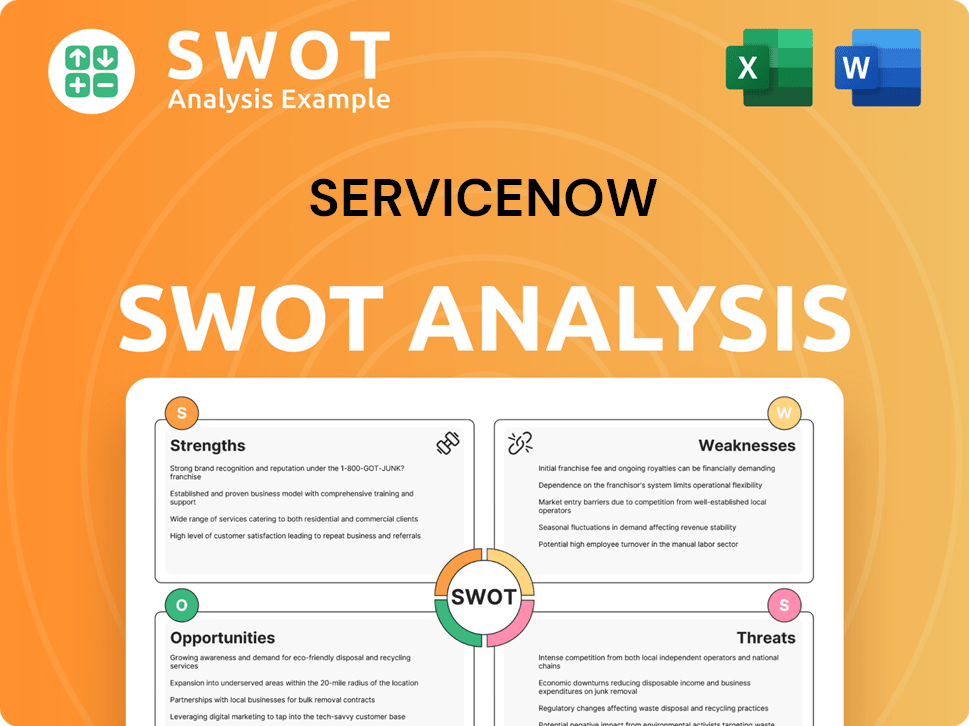
What Drove the Early Growth of ServiceNow?
The early growth and expansion of the ServiceNow company was marked by significant milestones and strategic shifts. Founded with a vision to transform IT service management, ServiceNow quickly gained traction in the market. This period saw the company evolve from its initial focus to a broader enterprise workflow platform.
ServiceNow's rapid growth was fueled by its cloud-based IT Service Management (ITSM) platform. By 2007, the company had achieved cash flow positivity and reported $13 million in annual revenue. This innovative approach disrupted the market, offering a modern alternative to on-premise solutions, and addressing IT managers' needs.
By January 2011, ServiceNow employed 275 people and had offices in multiple cities. The company partnered with Accenture to expand its reach. Frank Slootman was appointed CEO in April 2011 to help scale the company.
A significant milestone was the $210 million IPO in June 2012, followed by the relocation of its headquarters. ServiceNow expanded its offerings beyond IT, introducing the Now Platform to facilitate custom application development. The ServiceNow platform allowed organizations to build custom applications and automate processes more easily.
ServiceNow focused on customer satisfaction and continuous innovation, leading to substantial growth. As of December 31, 2024, ServiceNow had 2,109 customers with over $1 million in annual contract value (ACV), a 12% year-over-year increase, and nearly 500 customers with over $5 million in ACV, representing 21% year-over-year growth. In Q1 2025, subscription revenues reached $3.005 billion, a 19% year-over-year growth. For more insights, explore the Competitors Landscape of ServiceNow.
ServiceNow PESTLE Analysis
- Covers All 6 PESTLE Categories
- No Research Needed – Save Hours of Work
- Built by Experts, Trusted by Consultants
- Instant Download, Ready to Use
- 100% Editable, Fully Customizable
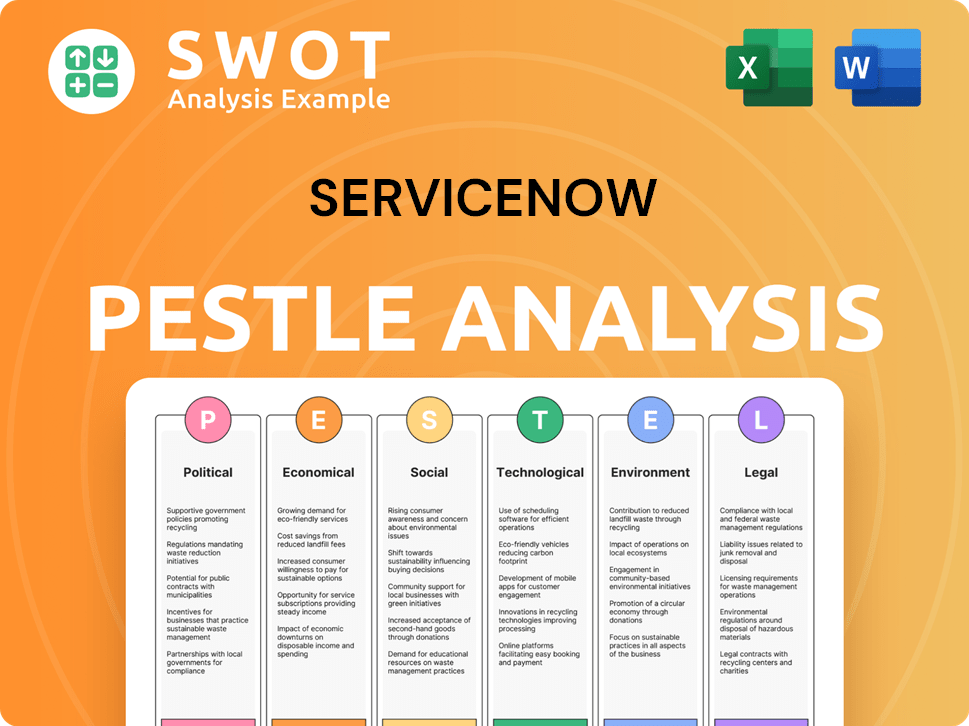
What are the key Milestones in ServiceNow history?
The ServiceNow history is marked by significant achievements and strategic shifts that have shaped its trajectory in the enterprise software market. From its inception, the company has consistently adapted to market demands, driving innovation and expanding its capabilities. The evolution of the company showcases its ability to navigate challenges and capitalize on opportunities, solidifying its position as a leader in the industry.
| Year | Milestone |
|---|---|
| 2004 | Founded by Fred Luddy, focusing on cloud-based IT service management solutions. |
| 2007 | Launched its first product, revolutionizing IT service management with a cloud-based platform. |
| 2012 | Completed its initial public offering (IPO), marking a significant step in its growth trajectory. |
| 2015 | Expanded beyond IT to include HR service delivery, customer service management, and security operations. |
| 2018 | Introduced the Now Platform, a low-code development platform. |
| 2024-2025 | Continued investment in AI and machine learning, with the Q1 2025 performance highlighting robust adoption of AI-centric offerings. |
Key innovations have been central to the ServiceNow platform's success. The development of its cloud-based IT service management (ITSM) platform offered a transformative alternative to traditional on-premise software. Furthermore, the introduction of the Now Platform, a low-code development platform, has empowered organizations to build custom applications and automate processes with greater ease.
ServiceNow revolutionized IT service management by offering a cloud-based platform, providing a more accessible and efficient solution compared to traditional on-premise software. This innovation allowed for easier updates, scalability, and broader accessibility for IT departments.
The Now Platform is a low-code development platform that empowers organizations to build custom applications and automate processes. This platform enhances agility, allowing businesses to quickly adapt to changing needs and improve operational efficiency.
ServiceNow has strategically integrated AI and machine learning into its platform, leading to faster response times, increased efficiency, and improved user experiences. This integration has improved the platform's capabilities.
ServiceNow consistently introduces new features and capabilities through its semi-annual releases, such as the Washington DC release in Q1 2024 with generative AI capabilities and Now Assist, and the Yokohama release in late Q1 2025, focusing on core platform updates. These updates address the ongoing need for digital transformation, automation, and AI integration across various industries.
ServiceNow expanded its capabilities beyond IT into areas like HR service delivery, customer service management, and security operations. This expansion broadened the company's market reach and diversified its product offerings.
ServiceNow has maintained a strong focus on customer needs, continuously introducing new features and capabilities through its semi-annual releases. This customer-centric approach has solidified its position in the enterprise software market.
ServiceNow has faced challenges, including scaling its infrastructure to meet explosive customer demand in its early years. The company has also navigated competitive threats from established players. In response to evolving market demands, ServiceNow has consistently introduced new features and capabilities through its semi-annual releases, such as the Washington DC release in Q1 2024 with generative AI capabilities and Now Assist, and the Yokohama release in late Q1 2025, focusing on core platform updates.
Early in its history, ServiceNow faced challenges in scaling its infrastructure to meet the rapid growth in customer demand. This required significant investment and strategic planning to ensure the platform could handle increasing workloads.
ServiceNow has had to compete with established players like SAP, Oracle, and Salesforce. These competitors have substantial resources and market presence, requiring ServiceNow to continuously innovate and differentiate its offerings.
The specialized nature of ServiceNow's platform has created relatively high entry barriers due to the demand for specialized technical personnel. This has required the company to invest in training and talent acquisition to support its growth.
The rapid growth of ServiceNow required strategic management, including the appointment of Frank Slootman as CEO to manage this expansion. This ensured that the company could handle the increasing demands and maintain its competitive edge.
ServiceNow has consistently introduced new features and capabilities through its semi-annual releases, such as the Washington DC release in Q1 2024 with generative AI capabilities and Now Assist, and the Yokohama release in late Q1 2025, focusing on core platform updates. These continuous updates address the ongoing need for digital transformation, automation, and AI integration across various industries.
ServiceNow has adapted to evolving market demands by continuously introducing new features and capabilities through its semi-annual releases. This has allowed the company to stay relevant and competitive in the enterprise software market.
ServiceNow Business Model Canvas
- Complete 9-Block Business Model Canvas
- Effortlessly Communicate Your Business Strategy
- Investor-Ready BMC Format
- 100% Editable and Customizable
- Clear and Structured Layout
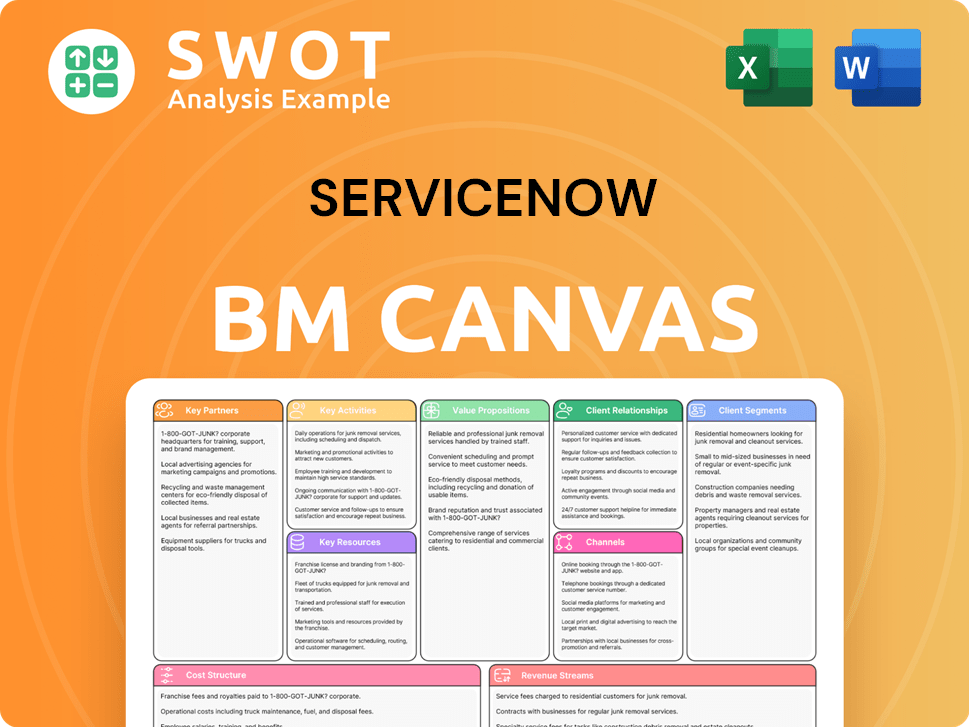
What is the Timeline of Key Events for ServiceNow?
The Revenue Streams & Business Model of ServiceNow has a compelling story, marked by significant milestones in its evolution. The company's journey began in 2003 when Fred Luddy founded Glidesoft, Inc., marking the start of the ServiceNow company. Over the years, the company has transformed, from its incorporation in California in 2004 to its current status as a leading cloud-based platform. Key events, including securing venture financing, changing its name to Service-Now.com, achieving profitability, and its initial public offering (IPO) in 2012, showcase its growth trajectory. The company's recognition as a top innovator by Forbes in 2018 and the appointment of key leadership figures like Bill McDermott and Gina Mastantuono further highlight its success. The release of new versions, such as Washington DC, Xanadu, and Yokohama, and the anticipation of the Zurich version, demonstrate its commitment to innovation and expansion in the market.
| Year | Key Event |
|---|---|
| 2003 | Fred Luddy founds Glidesoft, Inc., which would later become part of the ServiceNow history. |
| 2006 | The company changes its name to Service-Now.com. |
| 2012 | ServiceNow goes public with a $210 million IPO. |
| 2018 | Named number one on Forbes' list of the world's most innovative companies. |
| Q4 2024 | Reports subscription revenues of $2.866 billion, a 21% year-over-year growth. |
| Q1 2025 | Reports subscription revenues of $3.005 billion, a 19% year-over-year growth. |
ServiceNow is focused on expanding its AI capabilities, with agentic AI playing a crucial role in driving productivity. The company is also launching a core business suite specifically tailored for mid-market organizations, initially targeting companies with 1,000 to 5,000 employees. These strategic moves indicate a commitment to enhancing its platform and broadening its market reach. The company’s focus on AI and the mid-market indicates a strategic approach to growth.
Analysts predict continued strong growth, with subscription revenue estimated to be between $12.63 billion and $12.68 billion for 2025. The company’s earnings per share are expected to grow by 28.67% in the next year, from $8.93 to $11.49 per share. A transition to a consumption-based pricing model for AI and data solutions is planned for 2025. These financial strategies are designed to align costs with customer usage.
ServiceNow is emphasizing the democratization of application development through low-code/no-code tools, fostering innovation within organizations. CEO Bill McDermott highlights the 'massive opportunity' in AI and the company's unique position in orchestrating the entire technology value chain. This approach reflects the vision of ServiceNow founder Fred Luddy to build a cloud-based platform that enhances enterprise efficiency.
The company is consistently releasing new versions of its platform, such as Washington DC, Xanadu, Yokohama, and with Zurich anticipated for Q4 2025. Knowledge 2025 will focus on AI-powered service experiences and digital transformation. These releases and events demonstrate ServiceNow's commitment to continuous improvement and innovation.
ServiceNow Porter's Five Forces Analysis
- Covers All 5 Competitive Forces in Detail
- Structured for Consultants, Students, and Founders
- 100% Editable in Microsoft Word & Excel
- Instant Digital Download – Use Immediately
- Compatible with Mac & PC – Fully Unlocked
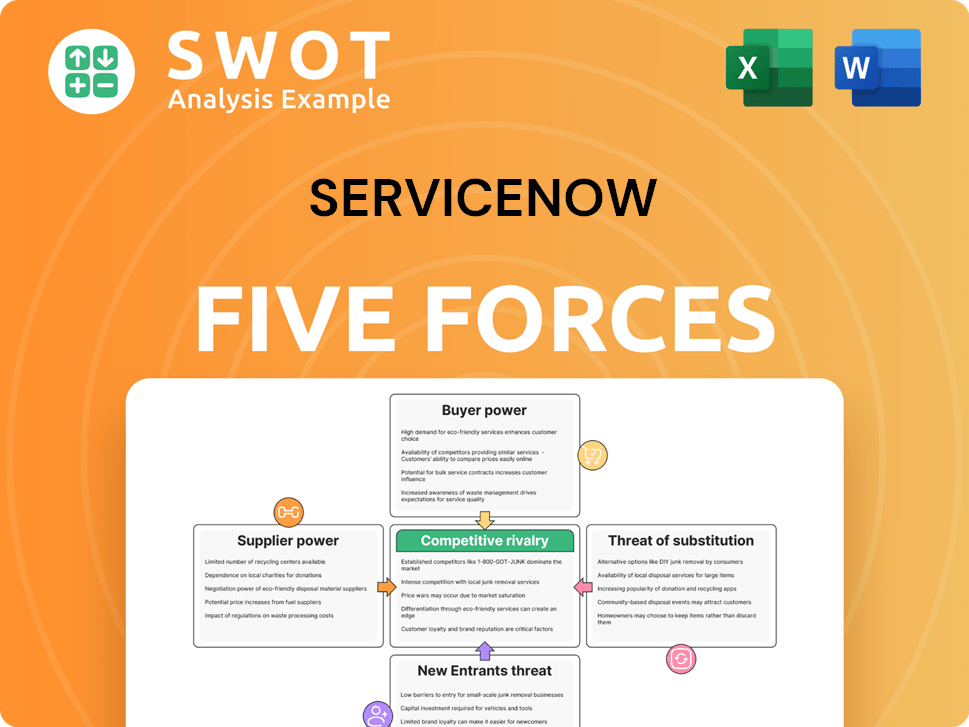
Related Blogs
- What is Competitive Landscape of ServiceNow Company?
- What is Growth Strategy and Future Prospects of ServiceNow Company?
- How Does ServiceNow Company Work?
- What is Sales and Marketing Strategy of ServiceNow Company?
- What is Brief History of ServiceNow Company?
- Who Owns ServiceNow Company?
- What is Customer Demographics and Target Market of ServiceNow Company?
Disclaimer
All information, articles, and product details provided on this website are for general informational and educational purposes only. We do not claim any ownership over, nor do we intend to infringe upon, any trademarks, copyrights, logos, brand names, or other intellectual property mentioned or depicted on this site. Such intellectual property remains the property of its respective owners, and any references here are made solely for identification or informational purposes, without implying any affiliation, endorsement, or partnership.
We make no representations or warranties, express or implied, regarding the accuracy, completeness, or suitability of any content or products presented. Nothing on this website should be construed as legal, tax, investment, financial, medical, or other professional advice. In addition, no part of this site—including articles or product references—constitutes a solicitation, recommendation, endorsement, advertisement, or offer to buy or sell any securities, franchises, or other financial instruments, particularly in jurisdictions where such activity would be unlawful.
All content is of a general nature and may not address the specific circumstances of any individual or entity. It is not a substitute for professional advice or services. Any actions you take based on the information provided here are strictly at your own risk. You accept full responsibility for any decisions or outcomes arising from your use of this website and agree to release us from any liability in connection with your use of, or reliance upon, the content or products found herein.